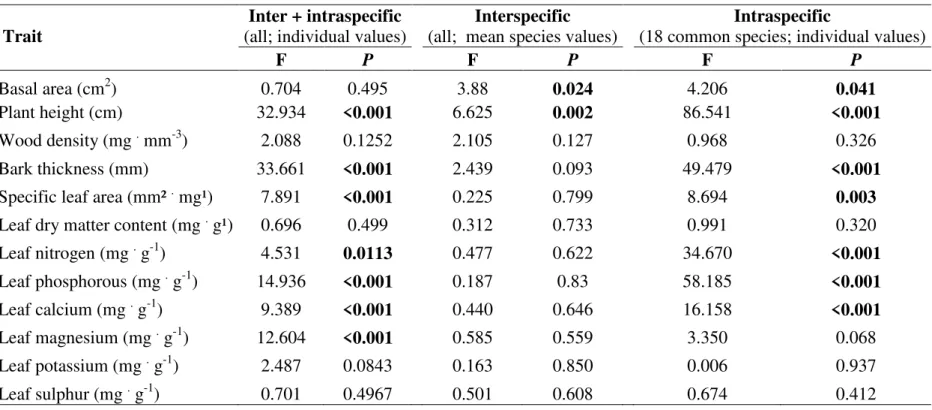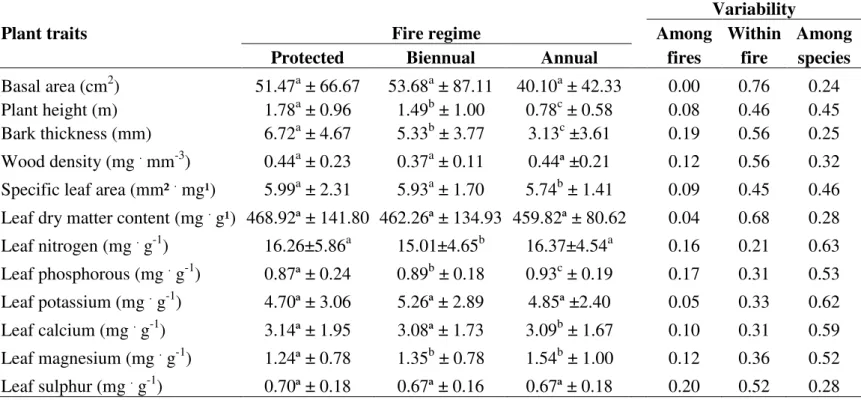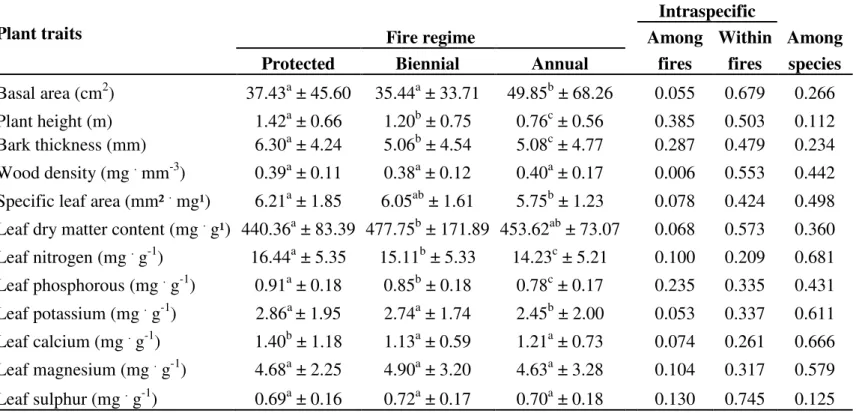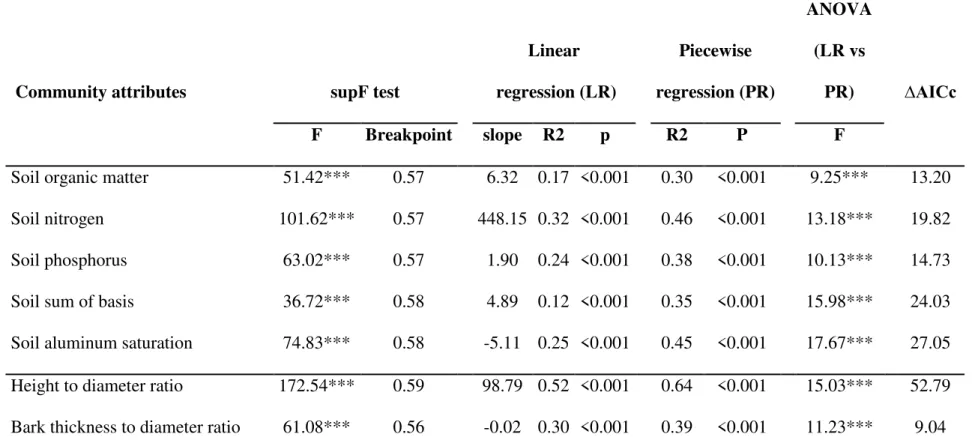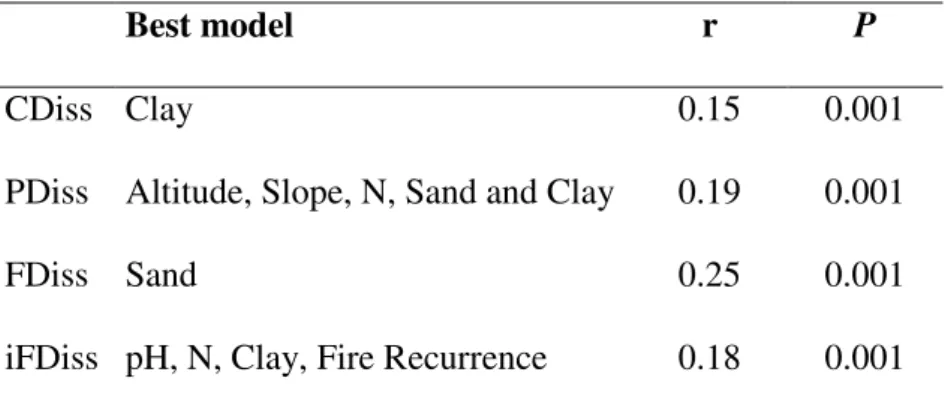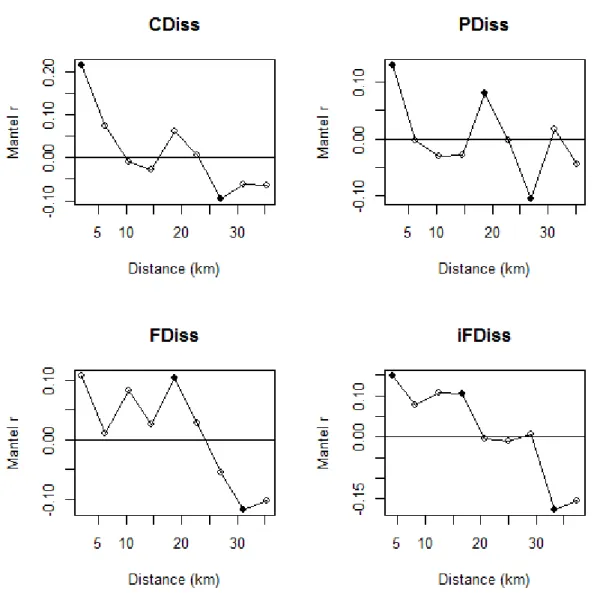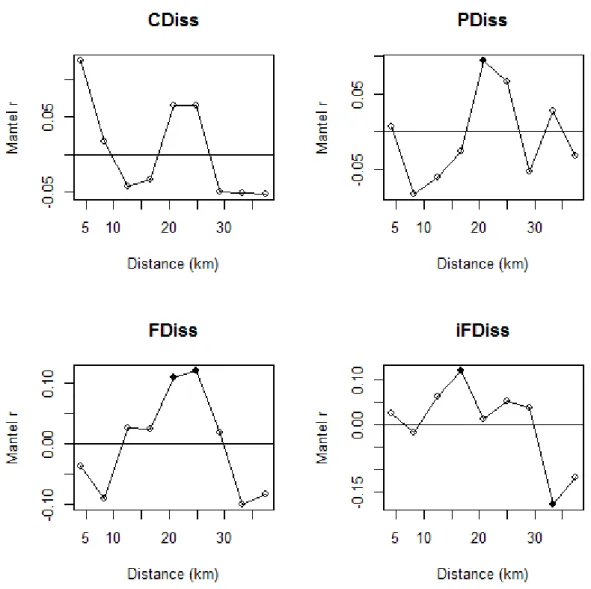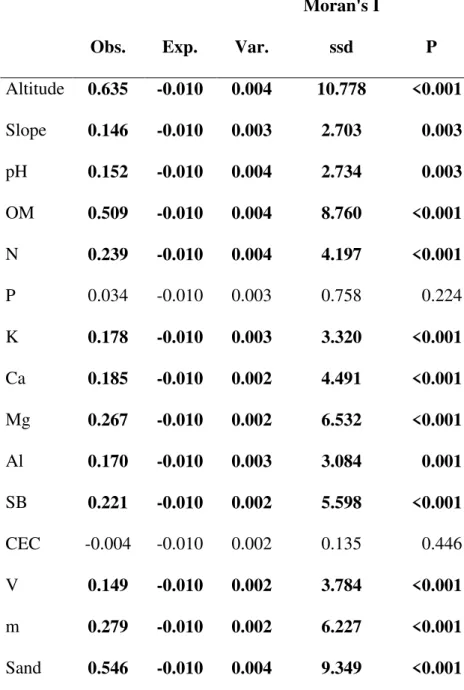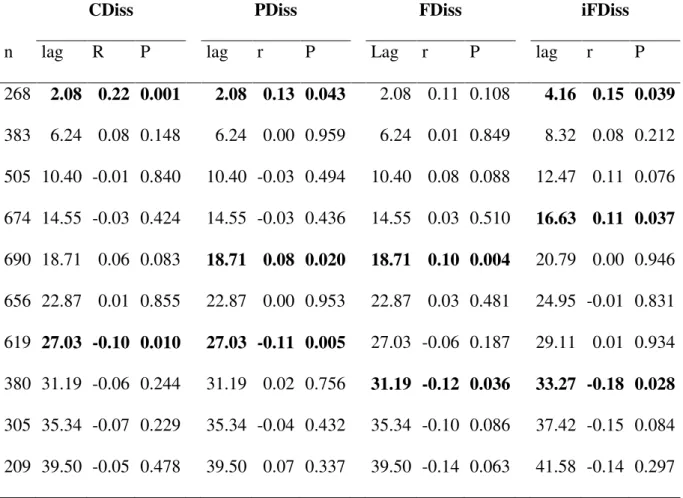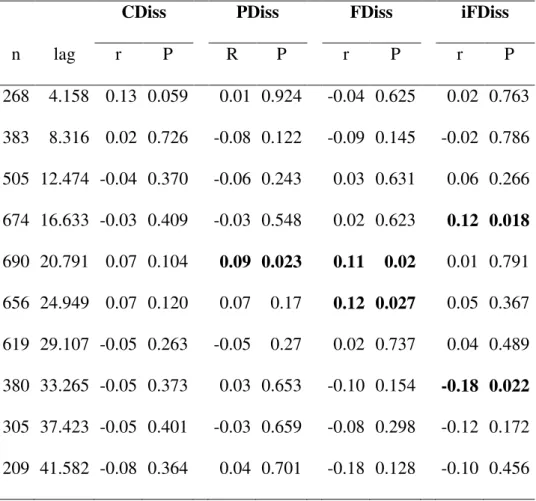UNIVERSIDADE FEDERAL DE SÃO CARLOS CENTRO DE CIÊNCIAS BIOLÓGICAS E DA SAÚDE
PROGRAMA DE PÓS-GRADUAÇÃO EM ECOLOGIA E RECURSOS NATURAIS
VINÍCIUS DE LIMA DANTAS
O PAPEL DO FOGO NA ESTRUTURAÇÃO FUNCIONAL E FILOGENÉTICA DE SAVANAS E FLORESTAS TROPICAIS
Orientador: Marco Antônio P. L. Batalha
UNIVERSIDADE FEDERAL DE SÃO CARLOS CENTRO DE CIÊNCIAS BIOLÓGICAS E DA SAÚDE
PROGRAMA DE PÓS-GRADUAÇÃO EM ECOLOGIA E RECURSOS NATURAIS
VINÍCIUS DE LIMA DANTAS
O PAPEL DO FOGO NA ESTRUTURAÇÃO FUNCIONAL E FILOGENÉTICA DE SAVANAS E FLORESTAS TROPICAIS
Tese apresentada ao Programa de Pós-Graduação em Ecologia e Recursos Naturais, do Centro de Ciências Biológicas e da Saúde da Universidade Federal de São Carlos como parte dos requisitos para a obtenção do título de doutor em Ciências com ênfase em Ecologia e Recursos Naturais.
Ficha catalográfica elaborada pelo DePT da Biblioteca Comunitária/UFSCar
D192pf
Dantas, Vinícius de Lima.
O papel do fogo na estruturação funcional e filogenética de savanas e florestas tropicais / Vinícius de Lima Dantas. -- São Carlos : UFSCar, 2014.
125 f.
Tese (Doutorado) -- Universidade Federal de São Carlos, 2014.
1. Ecologia. 2. Estrutura de comunidades. 3. Fogo e ecologia. 4. Ecologia do cerrado. 5. Nicho (Ecologia). 6. Ecologia de comunidades. I. Título.
AGRADECIMENTOS
Agradeço ao meu orientador Marco Antônio Batalha e ao meu co-orientador Juli G. Pausas pela confiança, disponibilidade e pelos valiosos ensinamentos.
À Fundação de Amparo a Pesquisa do Estado de São Paulo (processos 2008/57502-0 e 2010/01835-0), à Coordenação de Aperfeiçoamento de Pessoal de Nível Superior (CAPES; processo: 1019-11-2) e ao Conselho Nacional de Desenvolvimento Científico e Tecnológico (CNPq) pelos auxílios financeiros e pelas bolsas de estudo concedidas.
À minha família e meus amigos e, em especial à minha mãe Sônia Regina de Lima, meu pai Robinson José de Santana, meu irmão João Vitor de Lima Santana e minha companheira Lígia Nunes, por todo o suporte e amor que me deram e pelos momentos felizes que me proporcionaram – premissas fundamentais ao desenvolvimento de um trabalho de qualidade. Ao Instituto Brasileiro do Meio Ambiente e dos Recursos Naturais Renováveis (IBAMA) pela permissão para a realização do trabalho de campo no Parque Nacional das Emas.
Aos funcionários do Parque Nacional das Emas, ao Programa de Pós-Graduação em Ecologia e Recursos Naturais da UFSCar e ao Centro de Investigaciones sobre Desertificación pela
assistência logística em diferentes etapas do projeto.
À M.V. Cianciaruso, N. Escobar, A. Favari, V. Kadry, P.P. Loiola, R. Parmigiani, L.N.M. Ribeiro, N. Rosatti, G. Sartori, D.M. Silva, I.A. Silva e E.L. Silva Jr. pela valiosa ajuda no trabalho de campo.
ÍNDICE
Resumo ... 8
Abstract ... 9
I – Introdução Geral ... 10
II – Capitulo 1 ... 18
Abstract ... 20
Introduction ... 21
Matherial and Methods ... 23
Results ... 27
Discussion ... 27
References ... 31
III – Capitulo 2 ... 41
Abstract ... 43
Introduction ... 44
Matherial and Methods ... 47
Results ... 52
Discussion ... 53
References ... 58
Apendice ... 73
IV – Capitulo 3 ... 88
Abstract ... 90
Introduction ... 91
Matherial and Methods ... 94
Results ... 101
Discussion ... 102
References ... 107
11 O bioma savana ocupa aproximadamente um sexto da superfície terrestre (Grace et al. 2006). Estudos paleontológicos sugerem que o bioma se originou e adquiriu sua atual extensão há aproximadamente 10 milhões de anos atrás, coincidindo com a expansão e dominância das gramíneas C4 em escala global (Cerling et al. 1997, Beerling & Osborn
2006). Essa ascensão foi inicialmente atribuída a uma diminuição na concentração de gás carbônico atmosférico que teria favorecido gramíneas C4 (gramíneas dotadas de mecanismos
capazes de concentrar gás carbônico nos espaços intracelulares; Sage 2004) em detrimento das gramíneas C3 (Cerling et al. 1997, Ehleringer et al. 1997).
À época em que foi proposto, esse modelo tinha apenas apoio indireto, já que ainda não era possível estimar as concentrações de gás carbônico atmosférico dos paleoclimas com precisão. Assim, as principais bases para o modelo eram duas. Em primeiro lugar, experimentos de competição entre gramíneas C3 e C4, sob várias condições de concentração
de gás carbônico e temperatura, apontavam para a superioridade competitiva de gramíneas C4
em relação a C3 sob as condições prevalecentes nos trópicos (Ehleringer et al. 1997). Em
segundo lugar, uma diminuição na temperatura global no final do Mioceno, inferida por meio de isótopos estáveis de oxigênio, indicaria uma diminuição no efeito estufa (Raymo & Ruddiman 1992, Zachos et al. 2001), possivelmente resultante de uma diminuição no gás carbônico atmosférico (Cerling et al. 1997).
Com o surgimento de novas tecnologias isotópicas se tornou possível estimar diretamente as concentrações de gás carbônico na atmosfera do Mioceno. Evidências de diversas fontes independentes falharam em detectar qualquer variação importante nas concentrações de gás carbônico que coincidisse com ascensão das gramíneas C4 (DePonto & Pollard 2003, Beerling
12 árvores C3, formando bosques de estrutura variáveis (Keeley & Rundell 2005). Uma vez que
as gramíneas C4 são intolerantes à sombra, um modelo baseado puramente em competição
não poderia explicar como gramíneas C4 substituíram florestas de plantas C3. Assim, apesar
da evolução das gramíneas C4, cerca de 25 milhões de anos antes, coincidir com uma queda
global na concentração de gás carbônico atmosférico (Sage 2004, Christin et al. 2008), outros mecanismos seriam necessários para explicar a expansão das savanas e campos no final do Mioceno.
Em contrapartida, evidências fósseis apontam para o surgimento de um clima fortemente estacional no período, caracterizado por invernos secos e verões quentes e chuvosos nos trópicos (Keeley & Rundell 2005). Além disso, outras evidências revelaram um grande aumento no fluxo de partículas de carvão para o fundo dos oceanos no mesmo período, indicando um forte aumento na frequência de incêndios (Berling & Osborn 2006). Essas evidências, combinadas com estudos recentes sobre o papel atual do fogo nas savanas e seus ciclos anuais nos trópicos (Higgins et al. 2000, Bond et al. 2005, Sankaran et al. 2005), intimamente ligados aos ciclos das gramíneas C4, indicavam que o fogo teria sido um fator
chave no surgimento do bioma savana.
Um estudo filogenético posterior incluindo espécies da América do Sul (Simon et al. 2009) forneceria um apoio adicional a essa hipótese. Esse estudo apresenta evidências de que o surgimento das atuais espécies lenhosas de plantas das savanas sul-americanas coincide com o final do Mioceno. Uma vez que as principais características diferenciando as espécies de savana de suas irmãs de florestas secas e úmidas são suas altas resistências e resiliências ao fogo, as linhagens de cerrado parecem ter evoluído in situ em resposta aos novos regimes de
13 completamente a dinâmica das savanas sem compreender o seu papel enquanto fator ecológico, atuando na seleção de linhagens de plantas e moldando as características estruturais e funcionais das comunidades tropicais.
Atualmente, diversas regiões do planeta, sobretudo nos trópicos, possuem um clima úmido o suficiente para suportar a ocorrência de florestas, mas atualmente são cobertas por vegetações abertas de savana ou campo (Bond et al. 2005, Sankaran et al. 2005, Bond 2008). Essas diferenças têm sido atribuídas principalmente ao papel do fogo nessas regiões, mas há um consenso de que os efeitos do fogo são complexos e não lineares, interatuando com diversas outras variaveis (Bond et al. 2005, Staver et al. 2011, Murphy & Bowman 2012). Atualmente, sabe-se que ao gerar ciclos consecutivos de mortalidade aérea de árvores jovens seguidas de rebrotamento basal, o fogo mantém as árvores em um tamanho reduzido em savanas, impedindo que cresçam, se adensem e formem um dossel fechado (Kellman 1984; Higgins et al. 2000; Hoffmann et al. 2009). Assim, o fogo exerce gargalos demográficos nas populações plantas, levando a uma alta dominância de indivíduos anões, e esses gargalos exercem fortes pressões seletivas em favor de plantas resistentes ao fogo (Bond & van Wilgen 1996, Bond 2008). Dentro das populações, apenas uma pequena parcela dos indivíduos, aqueles de crescimento mais rápido (em espessura da casca ou total), seriam capazes de tornarem-se resistentes ao fogo antes do incêndio seguinte (Wakeling et al. 2011, Lawes et al. 2013). Entretanto, são os regimes de fogo e não a ocorrência de fogo que determinam qual estratégia é mais eficiente para escapar do fogo em diferentes savanas (Dantas & Pausas 2013).
14 al. 2012). O mais recente deles propõe que a transição de uma vegetação de savana para uma de florestas depende de dois limiares ecológicos (Hoffmann et al. 2012). O primeiro seria em nível individual e estaria relacionado ao momento crítico em que uma dada planta desenvolve uma casca grossa o suficiente para se tornar independente do fogo (Hoffmann et al. 2012). O segundo seria em nível de comunidade, quando uma comunidade de árvores desenvolve um dossel suficientemente denso e alto para reduzir a flamabilidade do sistema, tanto pela supressão de gramíneas C4, como pela alteração das condições microclimáticas (Hoffmann et
al. 2012, Murphy and Bowman 2012). A probabilidade de atingir esses limiares dependeria do tamanho do intervalo entre dois incêndios e da disponibilidade dos recursos necessários para sustentar um crescimento rápido durante esse intervalo. Além disso, essa transição dependeria dos atributos funcionais das espécies presentes na área, como seus investimentos em cascas grossas, das densidades das folhas em suas copas e de suas taxas de crescimento intrínsecas (Hoffmann et al. 2012, Murphy and Bowman 2012). Enquanto as espécies que evoluíram em savana possuem cascas especialmente grossas que lhes conferem uma alta resistência ao fogo (Hoffmann et al. 2009), espécies de floresta podem levar décadas para formar essas cascas (Hoffmann et al. 2009). Por outro lado, espécies de floresta têm altas taxas de crescimento e copas densas, o que lhes permitiria fechar o dossel da comunidade rapidamente (Hoffmann et al. 2012). Dessa forma, a probabilidade de cruzar o primeiro limiar seria maior para espécies de savana enquanto que a probabilidade de cruzar o segundo seria maior para espécies de floresta (Hoffmann et al. 2012). Apesar da coerência desse modelo, estudos empíricos apresentando evidências que o apoiem ainda são escassos.
15 assembleia de comunidades em savanas filtradas pelo fogo e por quais mecanismos eles operam?
Referências
Beerling DJ & Osborn CP (2006) The origin of the savanna biome. Global Change Biology 12: 2023-2031.
Bond WJ (2008) What limits trees in C4 grasslands and savannas. Annual Reviews in Ecology, Evolution, and Systematics 39: 641-659.
Bond WJ, Woodward FI & Midgley GF (2005) The global distribution of ecosystems in a world without fire. New Phytologist 165: 525-538.
Bond WJ & van Wilgen BW (1996) Fire and plants. Chapman & Hall, London, UK.
Cerling TE, Haris JM, MacFadden BJ et al. (1997) Global vegetation change through the Miocene/Pliocene boundary. Nature 389: 153-158.
Christin P-A, Besnard G, Samaritani E et al. (2008) Oligocene CO2 decline promoted C4
photosynthesis in grasses. Current Biology 18: 37-43.
Dantas VL & Pausas JG (2013) The lanky and the corky: fire-escape strategies in savanna woody species. Journal of Ecology 101: 1265-1272.
DePonto RM & Pollard D (2003) Rapid Cenozoic glaciation of Antarctica induced by declining atmospheric CO2. Nature 421: 245-249.
Ehleringer JR, Cerling TE & Helliker BR (1997) C4 photosynthesis, atmospheric CO2, and
16 Higgins SI, Bond WJ & Trollope WSW (2000) Fire, resprouting and variability: a recipe for
grass-tree coexistence in savanna. Journal of Ecology 88: 213-229.
Hoffmann WA, Adasme R, Haridasan M et al. (2009) Tree topkill, not mortality, governs the dynamics of savanna-forest boundaries under frequent fires in central Brazil. Ecology 90: 1326-1337.
Hoffmann WA, Geiger EL, Gotsch SG et al. (2012) Ecological thresholds at the savanna-forest boundary: how plant traits, resources and fire govern the distribution of tropical biomes. Ecology Letters 15: 759-769.
Grace J, José JS, Meir P et al. (2006) Productivity and carbon fluxes of tropical savannas. Journal of Biogeography 33: 387-400.
Keeley JE & Rundell PW (2005) Fire and the Miocene expansion of C4 grasslands. Ecology Letters 8: 683-690.
Kellman M (1984) Synergistic relationships between fire and low soil fertility in neotropical savannas: a hypothesis. Biotropica 16: 158-160
Lawes MJ, Midgley JJ, Clarke PJ (2013) Costs and benefits of relative bark thickness in relation to fire damage: a savanna/forest contrast. Journal of Ecology 101:517-524.
Murphy BP & Bowman DMJS (2012) What controls the distribution of tropical forest and savanna? Ecology Letters 15: 748-758.
Raymo ME & Ruddiman WF (1992) Tectonic forcing of late Cenozoic climate. Nature 359: 117-122.
17 Sankaran M, Hanal NP, Scholes RJ et al. (2005) Determinants of woody cover in African
savannas. Nature 438: 846-849.
Simon MF, Grether R, Queiroz LP de et al. (2009) Recent assembly of the Cerrado, a neotropical plant diversity hotspot, by in situ evolution of adaptations to fire. Proceedings of the National Academy of Science USA 106: 20359-20364.
Staver AC, Archibald S and Levin SA (2011) The global extent and determinants of savanna and forest as alternative biome states. Science 334: 230-232.
Wakeling JL, Staver AC & Bond WJ (2011) Simply the best: the transition of savanna saplings to trees. Oikos 120: 1448-1451.
18 II – CAPÍTULO 1: O PAPEL DO FOGO NA ESTRUTURAÇÃO DE TRAÇOS
FUNCIONAIS EM SAVANAS NEOTROPICAIS*
* Artigo publicado em 2013 no periódico Oecologiacom o título “The role of fire in
19
The role of fire in structuring trait variability in Neotropical
savannas
Vinícius de L. Dantas1, Juli G. Pausas2, Marco Antônio Batalha1, Priscilla de Paula Loiola1 and Marcus Vinicius Cianciaruso3
1 Universidade Federal de São Carlos, Departamento de Botânica, PO Box 676, 13565-905, São Carlos, SP, Brazil
2 CIDE-CSIC, Ctra. Naquera Km. 4.5 (IVIA), 46113 Montcada, Valencia, Spain
3 Universidade Federal de Goiás, Departamento de Ecologia, PO Box 131, 74001-970, Goiânia, GO, Brazil
20 Abstract
Intraspecific trait variability plays a fundamental role in community structure and dynamics; however, few studies have evaluated its relative importance to the overall response of communities to environmental pressures. Since fire is considered a key factor in Neotropical savannas, we investigated in what extent the functional effects of fire in a Brazilian savanna occurs via intra- or inter- specific trait variability. We sampled 12 traits in communities subjected to three fire regimes in the last 12 years: annual, biennial, and protected. To
evaluate fire’s relative effects we fitted a general linear mixed models with species as random and fire as fixed factors, using: 1) all species in the communities (i.e., considering intra and interspecific variabilities); 2) 18 species common to all fire regimes (i.e., intraspecific variability only), and; 3) all species with their overall average trait values (i.e., interspecific variability only). We assessed the relative role of inter- and intra- specific variability by comparing the significance of each trait in the three analyses. We also compared the within and between fire variabilities with a variance component analysis. Five traits presented larger intraspecific than interspecific variability, and the main effect of fire occurred at the intraspecific level. These results support that it is important to consider intraspecific variability to fully understand fire-prone communities. Moreover, trait variability was larger within than among fire regimes. Thus, fire may act more as an external filter, preventing some of the species from the regional pool to colonize the cerrado, than as an internal factor structuring the already filtered cerrado communities.
21 Introduction
Most studies on the effects of biotic interactions and abiotic drivers in plant communities have focused on interspecific trait variability, considering plant traits as species average values (for example, Westoby et al. 2002; Wright et al. 2005; Pausas and Verdú 2008; Kraft and Ackerly 2010). Including intraspecific variability in community studies is a promising path to improve our ability for understanding assembly processes, habitat selection, and community functioning, regardless of whether this variability has a genetic basis or not (McGill et al. 2006; Albert et al. 2010; Bolnick et al. 2011). Intraspecific variability is associated with greater resource use efficiency, greater microsite occupancy, and higher resilience at community level (Bolnick et al. 2011). Moreover, since intraspecific variability plays a fundamental role in species coexistence and interactions (Violle et al. 2012), the evaluation of the phenotypic community structure is significantly affected by its inclusion (Jung et al. 2010; Cianciaruso et al. in press). Few studies have evaluated the relative
importance of intraspecific variability to the response of communities to environmental gradients (Albert et al. 2010). However, the recent rise of variance-based statistics have provided a common ground for comparing and decomposing the effects of community processes into its intra- and inter- specific components (de Bello et al. 2010; Messier et al. 2010; Violle et al. 2012). Plant communities are generally assembled by two main processes: habitat filtering and limiting similarity (Weiher and Keddy 1995; Wilson et al. 1999). Since, habitat filtering tends to reduce interspecific trait variability (Kraft et al. 2008; Pausas and Verdú 2010), in strongly filtered communities the intraspecific variability is expected to play an important relative role in community structure and resilience.
22 fire effects in plant traits at a community scale have focused on changes related to shifts in species composition (e.g., Pausas et al. 2004; Saura-Mas and Lloret 2007; Verdú and Pausas 2007; Pausas and Verdú 2008; Moretti and Legg 2009). However, recent studies emphasised the role of intraspecific trait variability in fire-prone ecosystems (Moreira et al. 2012; Pausas et al. 2012; Cianciaruso et al. in press). Nevertheless, to what extent the effects of recurrent
fire in plant communities are related to intraspecific variability remains poorly explored. The origin of the Neotropical savannas is associated with the spread of flammable C4
grasses in South America about 4-8 million years ago (Berling & Osborn 2006; Simon et al. 2009). The appearance of such grasses increased the frequency of fires, imposing a strong filtering, as well as a selective pressure on the coexisting woody species. The resulting communities have an herbaceous layer of tall flammable grasses coexisting with woody species adapted to survive fires. Typical wildfires in the Brazilian savannas (known as
“cerrado”) occur in the wet season (generating small fires) or during the transition from dry to wet (generating larger fires; Miranda et al. 2009). In this vegetation type, because grasses are often tall and trees relatively short, there is no clear fuel gap between grasses and woody plant, and fires often affect both the herbaceous layer and the coexisting shrubs and trees, generating regimes of frequent low intensity fires (crown and surface fires). Consequently, the long fire history has filtered cerrado communities by preventing the establishment of species not adapted to fire, and by driving the evolution of a fire-adapted flora (Simon et al. 2009), thus limiting interspecific phenotypic and functional variability.
23 the relative importance of changes in species composition observed in cerrado communities submitted to different fire regimes (Silva and Batalha 2008) should not explain most of the functional trait variability; instead, an important part of the variability should occur at the intraspecific level. To evaluate this, we studied 12 functional traits of woody plants occurring in different fire regimes in a cerrado reserve. The current management of cerrado reserves generated a patchwork of fire regimes, from annual fires to fire-protected zones, suitable for studying trait variability generated by fire.
Material and methods
Study area
We used data collected at Emas National Park (ENP; central Brazil: 17°49’-18°28’S and 52°39’-53°10’W), a World Natural Heritage site (Unesco 2001) located in the Brazilian Central Plateau. ENP is one of the most important cerrado reserves in Brazil (Conservation International 1999). The reserve has a tropical warm wet climate, with dry winters (Aw type
following Köppen 1931); most soils are Oxisols. The topography is mostly flat and homogeneous. The cerrado includes a wide range of physiognomies, from open grassland to woodland with different tree densities (Coutinho 1990); most of these physiognomies occur inside ENP, but open formations are the most abundant ones.
24 (França et al. 2007), but the outcome of this management is a patchwork of different fire regimes within the park.
Sampling
Data were collected during a three month period of the 2006 rainy season, from areas with similar physiognomies (open savannas) and topography (flat areas), but different fire history during the last 12 years (Silva and Batalha 2010): (1) an annually burned firebreak
(18°18’50’’S, 52°54’00’’W; sampled one year after the last fire); (2) an area burned 5 times
during the last 12 year, with a mean fire interval of 1.8 (18°19’01’’S, 52°54’10’’W; sampled
3 years since the last fire); and (3) a site protected from fire for 12 years (18°17’28’’S,
52°53’41’’W). For simplicity, we refer to these fire regimes as ‘annual’, ‘biennial’ and
‘protected’. In each fire regime, 250 points separated by 10-m intervals were sampled along a 2.5 km transect. At each point, four plants were sampled using the point-center-quarter method (Müller-Dombois and Ellenberg 1974). Thus, in each of the fire regimes, a total of 1,000 individual plants were sampled, from 50 woody species. The distance between adjacent transects ranged from 0.5 to 2 km, and since the sites were all located in flat and homogeneous areas, no important environmental variability was expected among transects.
25 following Allen (1989). Wood density and chemical leaf attributes were measured in five individuals per species and fire regime. For multi-stemmed plants, basal area, and bark thickness were measured at the main (oldest) stem that was not killed by fire. To measure
woody density we collected a woody cylindrical sample of the plant’s main stem (or as close as possible to it), removed all the bark, and, using a calliper, we measured its diameter and length. We used these measures to estimate the volume of the sample. The woody density was obtained by dividing the dry mass of the sample (oven-dried at 80°C for 72 h) by its fresh volume. Bark thicknesses were estimated by removing a bark sample from the main stem with a knife and measuring its thickness with a calliper.
Leaf traits were measured in completely expanded, hardened, and mature sun leaves, with no symptoms of pathogen, herbivory, or senescence, and haphazardly selected from the outer canopy. To measure specific leaf area, we collected two leaves from each sampled individual, kept them in a cooler and subsequently scanned them. We used this digitalized images to estimate leaf area with the Image J 1.33 software (Rasband 2004). We determined specific leaf area dividing the area of the fresh leaves by their oven-dried (80°C for 72 h) mass.
Analyses
26 species composition or to intraspecific trait variability, we excluded intraspecific variability by calculating an overall mean trait values for each species, regardless of the fire regime, and matched these mean trait values with species presence and absence per fire regime. We performed an analysis of variance with fire as fixed factor, which permitted to assess trait variability explained by differences in species composition only. Finally, to test whether fire generated intraspecific variability, we fitted a GLMM using the 18 species common to all fire regimes (that is, excluding interspecific variability), using fire as fixed factor and species as random factor. Out of the 50 species sampled, these 18 species (Supplementary material - Table A1) represented: 28% of the woody species occurring across the three sites, 46% of the woody species in the protected (unburned) site, 50% of the woody species in the biennially burned site and 64% of the woody species in the annually burned site (Silva and Batalha 2010). We assessed the relative role of inter- and intra- specific variability generated by fire, by comparing the significance of each trait in the three analyses. We repeated all the analyses considering two fire regimes in order to perform the three pairwise comparison tests for each trait.
We also compared the variability generated by fire with the overall trait variability to assess the importance of fire in generating trait variability by performing a variance component analysis in a GLMM including all species and fire regimes, with fire regimes nested in species as a random factor. We performed the same analysis using only the 18 common species to partition the variability in intraspecific and interspecific variability and investigated whether the variability within species was larger than the variability among species, as a measure of the importance of the intraspecific variability to the overall trait variability. When necessary, we log-transformed the trait values prior to the analysis to approximate normality. All analyses were carried out with the “nlme” and “ape” libraries in
27 Results
Fire regimes significantly affected most traits when both, species composition and intraspecific variability were considered (Table 1 and 2). Removing the intraspecific variability resulted in the loss of most of the significant relationships, and only basal area and plant height (out of 12 traits) were significantly related to fire regimes. In contrast, removing the variability in species composition (when only the 18 species common to all fire regimes were considered) did not alter most of the relationship between fire regimes and traits observed in the whole community approach (Table 1 and 3). In both the first and the last case, plant height was lowest in the annually burned site and highest in the protected site (Table 2 and 3). Specific leaf area was lowest at the annually burned site in comparison with the protected site. Leaf nitrogen, magnesium, and phosphorus were lowest and leaf calcium was highest in the annually burned site. For any trait fire was the main factor explaining trait variability, since the within fire variability was larger than the between fire variability (Table 2). Nevertheless, the proportion of the variability explained by fire increases when the effect of species composition is excluded (Table 3).
Discussion
Fire regimes were significantly related to trait variability at landscape scale in cerrado. Although the Brazilian cerrado has been subject to recurrent fires during the last few millions years (Simon et al. 2009), current fire regimes still have a significant impact in generating trait variability (Silva and Batalha et al. 2010; Cianciaruso et al. in press), and especially
28 fire regimes (see Silva and Batalha 2008). Thus, the intraspecific variability seems to represent an important fraction of the overall variability generated by fire and cannot be neglected in future studies in cerrado. These results, combined with others reporting the importance of fire in generating intraspecific variability (for instance, Moreira et al. 2012; Pausas et al. 2012), suggest that studies on the effects of fire in plant communities would benefit from a more detailed observation of trait variability beyond species average values. All these results support our hypothesis of the prominent importance of intraspecific variability in strongly fire-filtered communities.
Partitioning the overall trait variability of the 18 species common to all fire regimes resulted in that all but five traits presented a larger intra- than inter- specific variability (Table 3). The combined effect of fire in filtering the species of the regional pool for thousands of years, reducing the overall interspecific variability, and recent fire regimes in generating intraspecific variability may result in this relatively large importance of intraspecific variability. To what extent this pattern may also occur in other strongly filtered communities worldwide remains to be explored.
Plants burned annually were shorter and had higher basal areas than plants protected from fire. This is likely to be a consequence of the recurrent topkilling by fire under annual fire
frequencies, that is, fire interfering with plant development, causing a “bonsai effect” (or
29 area to have higher specific leaf area than plants in the frequently burned sites; more frequent burning promoted smaller, thicker and tougher leaves. Since all the sites studied consisted of open physiognomies, it is unlikely that the differences in leaf trait result of different light incidence among fire regimes. Specific leaf area is considered a key trait that summarise the allocation trade-off between growth and defence or reserves (Chapin et al. 1993; Gurvich et al. 200). Therefore, lower specific leaf area values observed in the annually burned plants may be a 5consequence of slower growth rates, due to a higher allocation to reserves for annual resprouting (Moreira et al. in press). Also, they may represent a great investment in leaf
anti-herbivory resistance to protect the leaves from the increment in anti-herbivory that usually takes place after fires (Lopes and Vasconcelos 2011; Kersch-Becker and Lewinsohn 2012).
30 association between phylogenetic conservatism and intraspecific variability, which could be a subject to further investigation.
When partitioning the variance into its intra- and interspecific components, we observed that the variability within fire was greater than among fire regimes. Thus, although fire exerted a significant effect in trait variability at the intraspecific level, there was still a large variability not explained by fire regimes, suggesting that although fire acts as an important external filter (sensu Violle et al. 2012) in cerrado preventing plants from the regional pool,
without the appropriated traits, from colonising the cerrado (Simon et al. 2009), other internal factors may be responsible for most of the trait variability observed at the landscape. Nevertheless, previous studies also found larger within (local) than among communities (regional) intraspecific variability (see Supplementary material in Albert et al. 2010; Moreira et al. 2012), suggesting that this could be a general pattern in many plant communities worldwide.
In recent years, investigating the role of intraspecific variability has been regarded as a fundamental issue to community ecology, allowing a more precise prediction of community responses to environmental changes, and a greater understanding of community functioning (Albert et al. 2010, Messier et al 2010, Boldnick et al. 2011, Violle et al. 2012). Indeed, there is increasing evidence suggesting that intraspecific variability may be as large as or even larger than interspecific variability (Bello et al. 2010; Messier et al. 2010; our results). Thus, to understand fully the effects of fire in cerrado, and possibly in other strongly filtered communities, intraspecific trait variability need to be considered.
Acknowledgments
31 support and scholarships granted to the authors; to Instituto Brasileiro do Meio Ambiente e dos Recursos Naturais Renováveis (IBAMA), for research permission; to Emas National Park staff, for logistical assistance; to PK Amorim, SP Campos, CA Casali, IA Silva, AVF Jardim, MO Maia, LT Manica, FQ Martins, DM Silva, and L Sims, for helping us in field work; and to Charlotte Reemts, for kindly revising the English. JGP acknowledges the support from the VIRRA project (CGL2009-12048/BOS; the Spanish Government). The study complies with the current laws of Brazil.
References
Albert CH, Thuiller W, Yoccoz NG, Soudant A, Boucher F, Saccone P, Lavorel S (2010) Intraspecific functional variability: extent, structure and sources of variation. J Ecol 98:604–613. doi: 10.1016/j.ppees.2011.11.004
Allen SE (1989) Chemical analysis of ecological materials. Blackwell Scientific Publications,
Oxford
Berling DJ, Osborn CP (2006) The origin of the savanna biome. Global Change Biol 12:2023–2031 doi: 10.1111/j.1365-2486.2006.01239.x
Bolnick DI, Amarasekare P, Araújo MS, Bürger R, Levine JM, Novak M, Rudolf VHW, Schreiber SJ, Urban MC, Vasseur DA (2011) Why intraspecific trait variation matters in community ecology. Trends Ecol Evol 26:183-192.doi:10.1016/j.tree.2011.01.009
Chapin III FS, Autumn K, Pugnaire F (1993) Evolution of suites of traits in response to environmental stress. Am Nat 142:S78–S92
32 Coley PD, Bryant JP, Chapin III FS (1985) Resource availability and plant antiherbivore
defense. Science 230:895-899
Conservation International (1999) Ações prioritárias para a conservação do Cerrado e do Pantanal. Conservation International, Brasília
Cornelissen JHC, Lavorel S, Garniel E, Díaz S, Buchmann N, Gurvich DE, Reich PB, Steege H ter., Morgan HD, Heijden MGA van der, Pausas JG, Poorter H (2003) A handbook of protocols for standardized and easy measurement of plant functional traits worldwide. Aust J Bot 51:335-380. doi:10.1071/BT02124
Coutinho LM (1990) Fire in the ecology of the Brazilian Cerrado. In: JG Goldammer (ed) Fire in the Tropical Biota: Ecosystem Processes and Global Challenges. Ecological Studies Springer, Berlin, pp 82-105
Craine JM (2009) Resource strategies of wild plants. Princeton University Press, New Jersey Dantas VL, Batalha MA (2011) Vegetation structure: fine scale relationships with soil in a
cerrado site. Flora 206:341-346. doi:10.1016/j.flora.2010.11.003
de Bello F, Lavorel S, Albert CH, Thuiller W, Grigulis K, Dolezal J, Janecek S, Leps J (2010)
Quantifying the relevance of intraspecific trait variability for functional diversity. Methods Ecol Evol 2:163-174. doi: 10.1111/j.2041-210X.2010.00071.x
França H, Ramos-Neto MB, Setzer A (2007) O fogo no Parque Nacional das Emas. Biodiversidade. Ministério do Meio Ambiente, Brasília
Gurvich DE, Enrico L, Cingolani AM (2005) Linking plant functional traits with post-fire sprouting vigour in woody species in central Argentina. Austral Ecol 30:789-796. doi: 10.1111/j.1442-9993.2005.01522.x
He T, Pausas JG, Belcher CM, Schwilk DW, Lamont BB (2012) Fire-adapted traits of Pinus
33 Higgins SI, Bond WJ, February EC, Bronn A, Euston-Brown DIW, Enslin B, Govender N, Rademan L, O'Regan S, Potgieter ALF (2007) Effects of four decades of fire manipulation on woody vegetation structure in savanna. Ecology 88:1119-1125. doi:10.1890/06-1664 Hoffmann WA, Franco AC (2003) Comparative growth analysis of tropical forest and
savanna woody plants using phylogenetically independent contrasts. J Ecol 91:475-484. doi: 10.1046/j.1365-2745.2003.00777.x
Jackson JF, Adams DC, Jackson UB (1999) Allometry of constitutive defense: a model and a comparative test with tree bark and fire regime. Am Nat 153:614-632. doi: 10.1086/303201
Jung V, Violle C, Mondy C, Hoffmann L, Muller S (2010) Intraspecific variability and trait -based community assembly. J Ecol 98:1134–1140. doi: 10.1111/j.1365-2745.2010.01687.x Keeley JE, Pausas JG, Rundel PW, Bond WJ, Bradstock RA (2011) Fire as an evolutionary pressure shaping plant traits. Trends Plant Sci 16:406-411. doi:10.1016/j.tplants.2011.04.002
Keeley JE, Zedler PH (1998) Evolution of life histories in Pinus. In: Richardson DM (ed) Ecology and biogeography of Pinus Cambridge. University Press, Cambridge, pp 219-250 Keeley JE, Bond WJ, Bradstock RA, Pausas JG, Rundel PW (2012) Fire in Mediterranean
Ecosystems: Ecology, Evolution and Management. Cambridge University Press, Cambridge
Kersch-Becker MF, Lewinsohn TM (2012) Bottom-up multitrophic effects in resprouting plants. Ecology 93:9-16. doi: 10.1890/11-0756.1
Köppen W (1931) Grundriss der Klimakunde. Gruyter, Berlin
34 Lopes CT, Vasconcelos HL (2011) Fire Increases Insect Herbivory in a Neotropical Savanna.
Biotropica 43:612-618. doi: 10.1111/j.1744-7429.2011.00757.x
McGill BJ, Enquist BJ, Weiher E, Westoby M (2006) Rebuilding community ecology from functional traits. Trends Ecol Evol 21: 178:185. doi: 10.1016/j.tree.2006.02.002
McLaughlin SB, Wimmer R (1999) Calcium physiology and terrestrial ecosystem processes. New Phytol 142:373-417. doi: 10.1046/j.1469-8137.1999.00420.x
Messier J, McGill BJ, Lechowicz MJ (2010) How do traits vary across ecological scales? A case for trait-based ecology. Ecol Lett 13:838-848.doi: 10.1111/j.1461-0248.2010.01476.x Miranda HS, Sato MN, Neto WN, Aire FS (2009) The fire factor. In: Cochrane MA (ed) Tropical fire ecology: climate change, land use, and ecosystem dynamics. Springer, New York, pp 427-450
Moreira B, Tavsanoglu Ç, Pausas JG (2012) Local versus regional intraspecific variability in regeneration traits. Oecologia 168:671-677. doi:10.1007/s00442-011-2127-5
Moreira B, Tormo J, Pausas JG (in press). To resprout or not to resprout: factors driving intraspecific variability in resprouting. Oikos. doi: 10.1111/j.1600-0706.2011.20258.x Moretti M, Legg C (2009) Combining plant and animal traits to assess community functional
responses to disturbance. Ecography 32:299-309. doi: 10.1111/j.1600-0587.2008.05524.x Müller-Dombois D, Ellenberg H (1974) Aims and methods of vegetation ecology. Wiley and
Sons, New York
Pausas JG, Alessio G, Moreira B, Corcobado G (2012) Fires enhance flammability in Ulex parviflorus. New Phytol193:18-23. doi: 10.1111/j.1469-8137.2011.03945.x
35 Pausas JG, Keeley JE (2009) A burning story: the role of fire in the history of life. Bioscience
59:593-601. doi: 10.1525/bio.2009.59.7.10
Pausas JG, Verdú M (2008) Fire reduces morphospace occupation in plant communities. Ecology 89:2181-2186.doi:10.1890/07-1737.1
Pausas JG, Verdú M (2010) The jungle of methods for evaluating phenotypic and phylogenetic structure of communities. BioScience 60:614-625. doi: 10.1525/bio.2010.60.8.7
Pivello VR, Coutinho LM (1992) Transfer of macro-nutrients to the atmosphere during experimental burnings in an open cerrado (Brazilian savanna). J Trop Ecol 8:487-497. doi:10.1017/S0266467400006829
Ramos-Neto MB, Pivello VR (2000) Lightning fires in a Brazilian savanna National Park: rethinking management strategies. Environ Manage 26:675-684. doi: 10.1007/s002670010124
Rasband W (2004) ‘ImageJ: Image process and analysis in Java.’ National Institutes of
Health: Bethesda
Ruggiero P, Batalha MA, Pivello VR, Meirelles ST (2002) Vegetation-soil relationship in cerrado (Brazilian savanna) and semideciduous forest, Southeastern Brazil. Plant Ecol 160:1-16. doi: 10.1023/A:1015819219386
Saura-Mas S, Lloret F (2007) Leaf and shoot water content and leaf dry matter content of mediterranean woody species with different post-fire regenerative strategies. Ann Bot
99:545-554. doi: 10.1093/aob/mcl284
Silva DM, Batalha MA (2008) Soil–vegetation relationships in cerrados under different fire frequencies. Plant Soil 311:87-96. doi: 10.1007/s11104-008-9660-y
36 Simon MF, Gretherc R, Queiroz LP, Skemae C, Penningtone RT, Hughes CE (2009) Recent assembly of the Cerrado, a Neotropical plant diversity hotspot, by in situ evolution of adaptations to fire. P Natl Acad Sci 48:20359–20364. doi: 10.1073/pnas.0903410106 Unesco, United Nations Educational, Scientific, and Cultural Organization (2001) Cerrado
protected areas: Chapada dos Veadeiros and Emas National Parks. http://whc.unesco.org/en/list/1035. Accessed on 14-May-2012
Verdú M, Pausas JG (2007) Fire drives phylogenetic clustering in Mediterranean Basin woody plant communities. J Ecol 95:1316-1323. doi: 10.1111/j.1365-2745.2007.01300.x Violle C, Enquist BJ, McGill BJ, Jiang L, Albert CH, Hulshof C, Jung V, Messier J (2012)
The return of the variance: intraspecific variability in community ecology. Trends in Ecol
Evol 27:244-252. doi: 10.1016/j.tree.2011.11.014
Ward D, Spiegel M, Saltz D (1997) Gazelle herbivory and interpopulation differences in calcium oxalate content of leaves of a desert lily. J Chem Ecol 23:333-346. doi: 10.1023/B:JOEC.0000006363.34360.9d
Weiher E, Keddy PA (1995) The assembly of experimental wetland plant communities. Oikos 73:323-335
Westoby M, Falster DS, Moles AT, Vesk PA, Wright IJ (2002) Plant ecological strategies: some leading dimensions of variation between species. Annu Rev Ecol Syst 33:125-159. doi: 10.1146/annurev.ecolsys.33.010802.150452
Wilson JB (1999) Assembly rules in plant communities. In: Weiher E, Keddy P (eds) Ecological Assembly Rules: Perspectives, Advances, Retreats. Cambridge University Press, Cambridge, pp 130-164
38 Table 1. Results of the GLMM for the effects of fire regime (protected, biennial and annual) on 12 functional traits considering 1) Inter +
intraspecific variability, which combines all species in the community and individual plant traits (see Table 2; dfl=2, df2 ranges between 374 and 593); 2) interspecific variability only (dfl=2, df2 ranges between 96 and 98); and 3) Intraspecific variability among the 18 species most common species (see Table 3; dfl=2, df2 ranges between 246 and 352). Shown in parentheses is the subset of the data used in each analysis: number of species; trait resolution.
Trait (all; individual values) Inter + intraspecific
Interspecific (all; mean species values)
Intraspecific
(18 common species; individual values)
F P F P F P
Basal area (cm2) 0.704 0.495 3.88 0.024 4.206 0.041
Plant height (cm) 32.934 <0.001 6.625 0.002 86.541 <0.001
Wood density (mg . mm-3) 2.088 0.1252 2.105 0.127 0.968 0.326
Bark thickness (mm) 33.661 <0.001 2.439 0.093 49.479 <0.001
Specific leaf area (mm² . mg¹) 7.891 <0.001 0.225 0.799 8.694 0.003 Leaf dry matter content (mg . g¹) 0.696 0.499 0.312 0.733 0.991 0.320 Leaf nitrogen (mg . g-1) 4.531 0.0113 0.477 0.622 34.670 <0.001 Leaf phosphorous (mg . g-1) 14.936 <0.001 0.187 0.83 58.185 <0.001 Leaf calcium (mg . g-1) 9.389 <0.001 0.440 0.646 16.158 <0.001 Leaf magnesium (mg . g-1) 12.604 <0.001 0.585 0.559 3.350 0.068
Leaf potassium (mg . g-1) 2.487 0.0843 0.163 0.850 0.006 0.937
39 Table 2. Trait values of all species within the three fire regimes and results of variance component analysis comparing fire type and species.
“Protected” are sites with 12 years of the fire exclusion; “Biennial” and “Annual” refers to fire frequency during this period. Trait values are means ± SD (see text for sample size). In each row, values with different letters indicates significant differences in trait values among pairs of fire regimes determined by a general linear mixed model with species as random and fire as fixed factors
Variability
Plant traits Fire regime Among Within Among
40 Table 3. Trait values of the 18 species common in the three fire regimes. Values are mean (± SD) of each trait in fire regime, and their variance
components (scaled; among and within three fire regimes and among species). “Protected” represents 12 years of fire exclusion; “Biennial” and
"Annual" refers to fire frequency during a 12 years period. In each row, values with different letters represent significant differences in trait values among fire regimes determined by a general linear mixed model with species as random and fire as fixed factors
Intraspecific
Plant traits Fire regime Among Within Among
Protected Biennial Annual fires fires species
41 III – CAPÍTULO 2: O FOGO PROVOCA LIMIARES FUNCIONAIS NA TRANSIÇÃO
ENTRE SAVANA E FLORESTA*
* Artigo publicado em 2013 no periódico Ecologycom o título “Fire drives functional
42 Running head: Fire drives functional thresholds
Fire drives functional thresholds on the savanna-forest transition
Vinícius de L. Dantas1, Marco A. Batalha1 and Juli G. Pausas2,*
1 Universidade Federal de São Carlos, Department of Botany, PO Box 676, 13565-905, São Carlos, SP, Brazil
44 Key words: alternative stable states, Cerrado, community dynamics, ecological thresholds, fire regimes, phylogenetic diversity, physiognomic gradient, plant-fire feedback, plant functional traits, savanna-forest systems, tropical biomes.
Introduction
Forest and savanna are two major terrestrial biomes dominating tropical landscapes (Woodward et al. 2004). Although their occurrences at a global scale may be predicted by climate-based models, at regional to local scales patches of contrasting tree densities may occur within the same climatic conditions (Hoffmann et al. 2005, Bond 2008, Hirota et al.
2011, Staver et al. 2011, Ratnan et al. 2011, Murphy and Bowman 2012). Consequently,
more complex models have been proposed to explain the differences between climate-based predictions and the actual vegetation cover in tropical landscapes (Bond et al. 2005,
Archibald et al. 2009, Lehmann et al. 2011, Pueyo et al. 2010, Staver and Levin 2012). There
is an emerging consensus that fire plays a fundamental role in these systems and that its relationship with vegetation dynamics is more complex than what a simple correlative model would predict (Bond and Keeley 2005, Staver et al. 2011, Murphy and Bowman 2012).
A model based on alternative stable state theory and tree growth-fire interaction (the
‘tree growth-fire interaction’ model) has been recently proposed to explain the dynamics of
savanna-forest systems (Hoffmann et al. 2012a, Murphy and Bowman 2012). Such a model
was built upon the assumption that savanna and forest are two alternative stable states with distinct structures and functions that are maintained by positive plant-fire stabilizing feedbacks. The transition from savanna to forest would be dependent on the crossing of two ecological thresholds: (1) the fire-resistance threshold, i.e., the stage at which an individual
fire-45 vulnerable juvenile stage (Hoffmann et al. 2009); and (2) the fire-suppression threshold, i.e.,
the stage at which a woodland achieves sufficient canopy closure to dramatically reduce the flammability of the system (for example, decreased light and C4 grass density and increased
moisture; Hoffmann et al. 2012a). Because species common in forest environments need
more time to achieve critical bark thickness than species typical of savanna, the crossing of these thresholds would be dependent upon sufficient fire intervals (Hoffmann et al. 2012a). In
landscapes where fire frequency is high, the occurrence of forest is predicted to be associated to plant growth enhancers (for example, high water or nutrient availability; Hoffmann et al.
2009, Murphy and Bowman 2012). Although this idea is straightforward, most of the evidence for stable states in forest-savanna systems comes from indirect inferences and theoretical models (Hennenberg et al. 2006, Hoffmann et al. 2012a, Staver and Levin 2012).
Because fire inhibition may be achieved at tree densities much lower than those observed in forests (Trauernicht et al. 2012), finding field evidence of these critical switching points and their consequences at the community scale would provide a more mechanistic understanding of the processes driving stable states in the tropics.
Within this framework we aim to find evidence of functional and diversity shifts consistent with two vegetation states in the Brazilian Cerrado domain, a fire-prone mosaic of savannas and forests with variable structures (Oliveira-Filho and Ratter 2002, Hoffmann et al.
2005). In this system annual rainfall and dry season soil water availability have lower predictive power for plant physiognomies than in Australian and African savanna-forest systems (Murphy and Bowman 2012), and except for the driest sites all levels of tree cover may occur within the same climatic conditions (Goodland and Pollard 1973, Oliveira-Filho and Ratter 2002, Hoffmann et al. 2005). Although early studies attributed the physiognomic
46 evidence suggests that soil fertility and texture alone are weak predictors of tree density (Lehmann et al. 2011, Staver et al. 2011, Hoffmann et al. 2012a) because: (1) savanna and
forests have been found to be associated with a diversity of edaphic conditions (Haridasan 1992, Hoffmann et al. 2012a); (2) forest species are able to colonize and grow in these
savannas in the absence of fire (Hoffmann and Franco 2003, Hoffmann et al. 2009); and (3) there is sufficient nutrient stock in the soils of open Cerrado physiognomies to support a forest biomass (Bond 2010). Forests within Cerrado landscapes tend to experience more fires than forests in other savanna-forest systems (Murphy and Bowman 2012), but the fire frequency is much lower than in open Cerrado physiognomies (Hoffmann et al. 2009, 2012a).
Because Cerrado landscapes include patches with significant variability in tree densities, they offer an excellent opportunity to study functional changes and threshold effects along this community closure gradient. We hypothesized that in Cerrado landscapes, despite the existence of a gradient of community structure (from open savannas to closed forests), there are two well-defined stable states of community function, each associated with contrasting levels of community closure and maintained by different fire regimes. Consequently, we predicted the existence of an abrupt shift in community parameters along a community closure gradient reflecting distinct vegetation states, particularly in the community parameters related to fire-plant feedbacks. Given that open communities are more flammable and that fire opens up the communities (Gambiza et al. 2000, Hennenberg et al. 2006, Higgins et al.
47 protect themselves from fire by efficiently closing the canopy and reducing the flammability of the system (Hoffmann et al. 2012b). In landscapes where fire is frequent forests are
predicted to be restricted to high resource soils, which decreases the time needed to accumulate fire-protective barks and to achieve canopy closure and thus fire inhibition (Hoffmann et al. 2009). Thus, we expect soil fertility to change abruptly along the community closure gradient. Finally, the consequences of different ecological settings (light and nutrient availability, fire regime) between open and closed communities should also have implications for species assembly and community diversity. To evaluate these predictions, we sampled plant functional traits, soil nutrients, and plant diversity attributes along a savanna-forest gradient (that is, a community closure gradient) in a Cerrado reserve (Emas National Park, Brazil) and tested for the existence of consistent thresholds separating communities with contrasting fire regimes. Our results will be consistent with two vegetation states maintained by plant-fire stabilizing feedbacks if (1) community attributes (particularly the ones discussed above) show a significant breakpoint along the community closure gradient; (2) the threshold model defined by this breakpoint explains substantially more variability than a linear model; and (3) there are different fire regimes on the different sides of the threshold.
Materials and Methods
Study site
Emas National Park (ENP) is a 132,000 ha World Heritage site containing flora, fauna, and key habitats that characterize the Cerrado. It is located in the Brazilian Central Plateau, in
48 forests cover approximately 25% and 1.2% of the area, respectively (Ramos-Neto and Pivello 2000; see Appendix A). The climate is tropical humid (Aw, following Köppen 1931), with two well-defined seasons: a dry season (from May to September) and a warmer rainy season (from October to April). The annual rainfall varies between 1200 and 2000 mm, concentrated mainly from October to March, and mean annual temperature is 24.6°C (Ramos-Neto and Pivello 2000). The soils are mainly dystrophic Oxisols. Until 1984, the park was exploited by cattle ranchers, and fire was used to generate fodder (Ramos-Neto and Pivello 2000). After a large fire in 1994 that burned most of the park, the fire management policy of the reserve was changed: natural fires are now allowed in the park, and a network of annually burned firebreaks limits the spread of fires (Ramos-Neto and Pivello 2000). Hence, large fires burning throughout the park became less frequent. During the sampling period, the ENP was a mosaic of patches with differing fire histories.
Sampling
Using a map of time since last fire and a GIS, we set 100 5 m x 5 m plots stratified by fire age and located near small roads. For practical and legal reasons, plots that fell in an inaccessible region of the park were discarded. We also discarded plots with fewer than three
woody individuals (stem diameter at the ground level ≥ 3 cm) and those with fewer than two
49 and there were no strong topographic differences among the sampled plots. During the rainy seasons of 2009/10 and 2010/11 we sampled, in each plot, all woody individuals with stem
diameter at the ground level ≥ 3 cm and identified them to species. For each individual we
measured plant height, stem diameter, bark thickness and leaf toughness, and collected leaf,
wood and soil samples for further analyses (see “Field sampling” in Appendix B). In the
laboratory, we calculated the height-to-diameter ratio and bark thickness-to-diameter ratio and measured the specific leaf area, leaf nitrogen, phosphorus and potassium content, and wood
density (see “Plant functional traits” in Appendix B). These functional traits are related to fire
resistance (bark thickness-to-diameter ratio; Lawes et al. 2012), vegetative recovery ratios
(wood density; Curran et al. 2008), topkill (height-to-diameter ratio; Dantas et al. 2012),
shade-tolerance (specific leaf area, Westoby et al. 2002) and nutrient use (specific leaf area,
leaf toughness and leaf nutrient contents; Westoby et al. 2002, Craine 2009). Traits were
measured in all individual plants because intraspecific variability is an important component of trait variability that influences species assembly (Jung et al. 2010, Dantas et al. 2013, Viole et al. 2012). Composite soil samples from each plot were sent to the Soil Science Laboratory
at the University of São Paulo, where soil organic matter content (OM) and the concentration of available phosphorus (P), total nitrogen (N), cations (Ca, Mg, K) and aluminum (Al) were
determined (see “Soil data” in Appendix B).
Fire history
50 inverse of fire-frequency in the plot. We assigned the maximum fire interval (32 years) for plots that had not burned within the period we examined.
Community closure index
To test whether community parameters displayed a threshold relationship along the savanna-to-forest gradient, we calculated a community closure index (CCI) as the sum of the woody volume of all plants in the plot, standardized to vary from 0 to 1. We computed the woody volume of each individual tree assuming a cone shape (i.e., basal area x height / 3). The index was used as an indicator of the light environment, from open communities (CCI close to 0) to closed communities (CCI close to 1). We did not consider tree cover because of the low resolution at the extremes of the gradient. Basal area was also discarded because plots with the same basal area (especially at intermediate basal area values) may vary substantially in structure depending on the height of the plants. Our index is expected to be more sensitive to fine-scale variability in light incidence than tree cover or basal area, and is therefore more appropriate for testing our hypothesis (see Appendix C). Indeed, evidence points out that woody volume is better in distinguishing Cerrado physiognomies than basal area (Batalha et al. 2001). Moreover, combined plant height and stem diameters are good predictors of canopy
leaf biomass in the Cerrado (Delitti et al. 2006), and there is evidence that wood volume is
also a good predictor (Salis et al. 2006). Thus, we expected CCI to reflect the changes in
51
Numerical analyses
We computed alpha and beta diversity for each plot along the CCI gradient, considering both traditional (non-phylogenetic) as well as phylogenetic-based indices, as described in Appendix B.
52 the structural change analysis to separate the area into two states (low and high CCI). We then compared mean fire intervals between the two states with Student’s t-test. We carried out all
the analyses in R v 2.11 (R Development Team 2011) using the “betapart”, “picante”,
“strucchange” and “vegan” libraries.
Results
53 Considering all significant breakpoints in the supF test, the mean threshold was located at CCI = 0.57 (SD = 0.009). This mean threshold separated two clear states with contrasting community attributes (Fig. 2, Appendix E). The mean fire interval differed significantly before and after this mean threshold (t-test; t = -9.085, p < 0.001) with clearly longer mean fire intervals associated with plots located at the high end of the CCI gradient (Fig. 3).
Discussion
Soil properties, phylogenetic and non-phylogenetic beta-diversities, and most of the plant functional traits presented a threshold pattern along the CCI gradient with coinciding breakpoints – providing strong evidence of a functional threshold along the forest-savanna gradient. Open environments consisted of communities growing on poor soil and dominated by short species with early investments in thick barks, low wood density and with thick and tough leaves (high toughness and low specific area). In contrast, closed communities grow in more fertile soils and include plants having the opposite functional attributes. Moreover, we found contrasting fire regimes on the two sides of the threshold, with open formations showing shorter fire intervals than closed formations and a switch from communities dominated by fire-resistant plants to communities dominated by shade tolerant species that compensate for their lack of fire resistance by efficiently closing the canopy (i.e., reducing flammability). Overall, our results are consistent with the theoretical model of fire-plant feedbacks as main drivers of the coexistence of two stable states, savanna and forest (Hoffmann et al. 2012a, Murphy and Bowman 2012). In this context, we provide the first
54 The functional characteristics of plants associated with the two states support the idea that these communities are maintained by plant-fire feedbacks. In open communities, grasses are often tall, whereas trees and shrubs are small, leaving no fuel gaps between grasses and woody plants (Appendix A-f). Consequently, fires in open communities affect the whole plant (Appendix A-a). However, Cerrado plants typically have thick, often corky barks that protect the whole stem (see Appendix A-d for an example). Depending on the fire intensity, the bark effectively protects a portion of fully scorched branches, and the plant resprouts epicormically from the protected lateral buds. This pattern results in trees with branched architectures. When combined with recurrent topkill and the need for stocking resources for resprouting, it results in slow growth in height (low height-to-diameter ratios; Higgins et al. 2007, Dantas et al.
2013) and light woods (high rates of vegetative resprout; Curran et al. 2008). This pattern
differs from other savannas (e.g., many oak savannas and pine savannas) in which plants have a relatively thick stem bark and there is a clear fuel gap between the grass layer and the overstory protecting branches and leaves from surface fires (Glitzenstein et al. 1995, Peterson
and Reich 2001, Keeley et al. 2012). In contrast, open Cerrado trees with corky bark in both
stem and branches are similar to some Mediterranean trees with very thick bark that resprout epicormically after crown fires (Pausas 1997, Catry et al. 2012). In closed communities, fire
is inhibited because shade-tolerant plants quickly occupy light gaps, preventing light-demanding C4 grasses from establishing. This effect, combined with the changes in
microclimatic condition promoted by a closed canopy, drastically reduces the flammability of the system (Hoffmann et al. 2012b), allowing these fire-sensitive shade-tolerant species which possess high wood density to support large crowns (Enquist et al. 1999, Markesteijn et al.
55 preventing tree and stem mortality in neotropical forests and savannas (Hoffmann et al. 2009,
Brando et al. 2012), high wood density, large stem diameter, and high canopies are also
associated with reduced levels of stem mortality in tropical savannas and forests (Archibald and Bond 2003, Brando et al. 2012). These characteristics of forest species as well as the high
absolute bark thickness provided by large stems may be important to prevent low-intensity surface fires from opening the community.
High and low specific leaf areas were associated with closed and open communities, respectively. Specific leaf area is a key trait related to the leaf economic spectrum, and high specific leaf area is associated with high photosynthetic capacity and fast leaf turnover (Westoby et al. 2002). These characteristics are largely linked to shade tolerance and
promotion because they confer an efficient response to light patchiness (Westoby et al. 2002).
These attributes may allow forest shade-tolerant species to quickly reach canopy closure in the absence of fire so that mixed communities of shade-tolerant and shade-intolerant species become unstable and rare (Hoffmann et al. 2009, Ratnam et al. 2011), leading to a threshold
pattern. On the open side of the threshold, soils are nutrient poor and recurrent fires cause frequent nutrient losses by consuming live and dead biomass (Pivello and Coutinho, 1992); the need for a large carbohydrate reserve for resprouting in this system may favor plants with high nutrient-use efficiency and leaves with high investments in leaf structure and low palatability to herbivores to avoid nutrient loss (low specific leaf areas and high leaf toughness; Westoby et al. 2002, Craine 2009).
56 preventing the development of a forest biomass (Bond 2010). Indeed, many forest species are able to establish and develop in nutrient-poor soils of adjacent neotropical savannas suggesting that the nutrient pool is not a limiting factor to forest species (Hoffmann et al. 2009). Moreover, tropical savannas and forest have been found occurring within both nutrient-rich and nutrient-poor soils (Bond 2008, Bond 2010, Hoffmann et al. 2012a) and
without sufficiently long fire intervals, forest cannot replace savannas, despite soil fertility (Hoffmann et al. 2009, 2012a, Rossatto et al. 2009). Instead, increasing evidence suggests
that the effect of soil on tree growth rates and how it affects the probability of a given community achieving fire inhibition are more likely to be the pathways by which soil affects biome distribution in the tropics (Bond 2010, Hoffmann et al. 2012a, Murphy and Bowman 2012). Because the breakpoints in fire-related traits coincide with those of soil, our results are consistent with the idea of fire as the main driver of the thresholds observed here whereas soil fertility decreases the time needed for crossing the fire-inhibition threshold (Hoffmann et al. 2009, Hoffmann et al. 2012a).
Flammability in the Cerrado is a function of community closure, and it shifts abruptly once a certain level of community closure is achieved. After this point, fire recurrence and/or intensity are predicted to be critically low (Hoffmann et al. 2012b). Our results for three
decades of fire history support this prediction. The contrasting fire regimes associated with contrasting patterns in community parameters, including fire-related ones, indicate that plant-fire stabilizing feedbacks are linked to changes in plant-fire regimes. Changes in plant-fire regime associated with community closure were also observed in the Australian savannas, where low-intensity fires or fire inhibition was associated with closed canopy communities and high-intensity fires were associated with open-canopy communities (Trauernicht et al. 2012). Open
